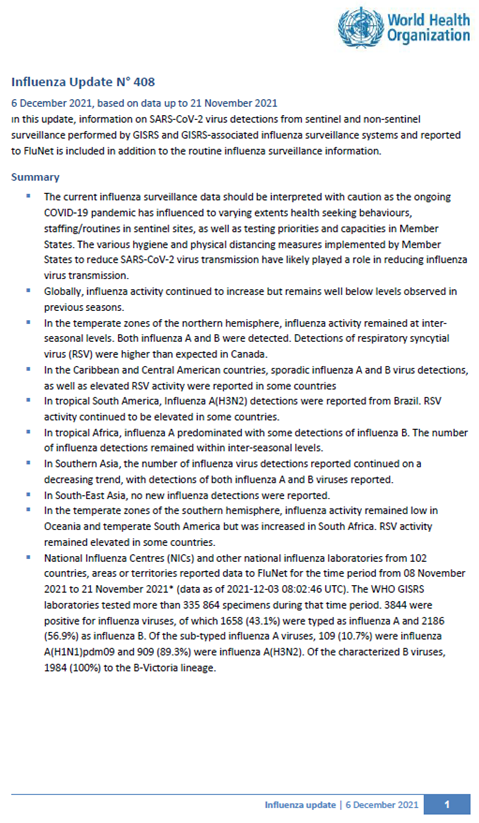Influenza Update N° 408

Overview
6 December 2021, based on data up to 21 November 2021
Information in this report is categorized by influenza transmission zones, which are geographical groups of countries, areas or territories with similar influenza transmission patterns. For more information on influenza transmission zones, see the link below:
Influenza Transmission Zones (pdf, 659kb)
- The current influenza surveillance data should be interpreted with caution as the ongoing COVID-19 pandemic has influenced to varying extents health seeking behaviours, staffing/routines in sentinel sites, as well as testing priorities and capacities in Member States. The various hygiene and physical distancing measures implemented by Member States to reduce SARS-CoV-2 virus transmission have likely played a role in reducing influenza virus transmission.
- Globally, influenza activity continued to increase but remains well below levels observed in previous seasons.
- In the temperate zones of the northern hemisphere, influenza activity remained at inter-seasonal levels. Both influenza A and B were detected. Detections of respiratory syncytial virus (RSV) were higher than expected in Canada.
- In the Caribbean and Central American countries, sporadic influenza A and B virus detections, as well as elevated RSV activity were reported in some countries.
- In tropical South America, Influenza A(H3N2) detections were reported from Brazil. RSV activity continued to be elevated in some countries.
- In tropical Africa, influenza A predominated with some detections of influenza B. The number of influenza detections remained within inter-seasonal levels.
- In Southern Asia, the number of influenza virus detections reported continued on a decreasing trend, with detections of both influenza A and B viruses reported.
- In South-East Asia, no new influenza detections were reported.
- In the temperate zones of the southern hemisphere, influenza activity remained low in Oceania and temperate South America but was increased in South Africa. RSV activity remained elevated in some countries.
- National Influenza Centres (NICs) and other national influenza laboratories from 102 countries, areas or territories reported data to FluNet for the time period from 08 November 2021 to 21 November 2021* (data as of 2021-12-03 08:02:46 UTC). The WHO GISRS laboratories tested more than 335 864 specimens during that time period. 3844 were positive for influenza viruses, of which 1658 (43.1%) were typed as influenza A and 2186 (56.9%) as influenza B. Of the sub-typed influenza A viruses, 109 (10.7%) were influenza A(H1N1)pdm09 and 909 (89.3%) were influenza A(H3N2). Of the characterized B viruses, 1984 (100%) to the B-Victoria lineage.

- During the COVID-19 pandemic, WHO encourages countries, especially those that have received the multiplex influenza and SARS-CoV-2 reagent kits from GISRS, to continue routine influenza surveillance, test samples from influenza surveillance sites for influenza and SARS-CoV-2 viruses where resources are available and report epidemiological and laboratory information in a timely manner to established regional and global platforms (see the guidance here: https://apps.who.int/iris/rest/bitstreams/1316069/retrieve).
- At the global level, SARS-CoV-2 percent positivity from sentinel surveillance continued to decrease and was under 10%. Activity remained under 10% positivity for all regions except the European Region of WHO, where an increasing trend in positivity was observed. Overall positivity from non-sentinel sites continued to decrease, remaining just under 7%. However, among the WHO South-East Asian region non-sentinel sites, positivity continued to increase to almost 35%.
- National Influenza Centres (NICs) and other national influenza laboratories from 48 countries, areas or territories reported data to FluNet for the time period from six WHO regions (African Region: 1; Region of the Americas: 13; Eastern Mediterranean Region: 4; European Region: 21; South-East Asia Region: 4; Western Pacific Region: 5 ) reported to FluNet from sentinel surveillance sites for time period from 08 Nov 2021 to 21 Nov 2021 (data as of 2021-12-03 08:02:46 UTC). The WHO GISRS laboratories tested more than 56 617 sentinel specimens during that time period and 8636 (15.3%) were positive for SARS-CoV-2. Additionally, more than 1 307 708 non-sentinel or undefined reporting source samples were tested in the same period and 90 228 were positive for SARS-CoV-2. Further details are included at the end of this update.
Source of data
______________________________________________________________________________________________
The Global Influenza Programme monitors influenza activity worldwide and publishes an update every two weeks. The updates are based on available epidemiological and virological data sources, including FluNet (reported by the WHO Global Influenza Surveillance and Response System), FluID (epidemiological data reported by national focal points) and influenza reports from WHO Regional Offices and Member States. Completeness can vary among updates due to availability and quality of data available at the time when the update is developed.
*It includes data only from countries reporting on positive and negative influenza specimens.
